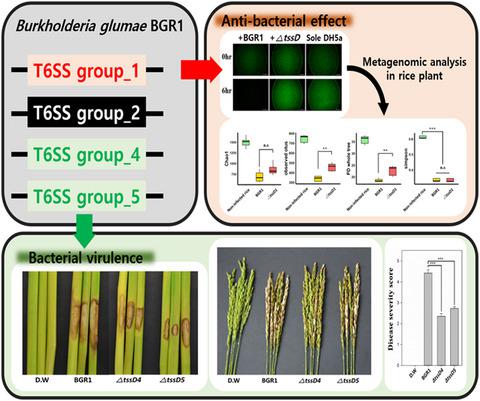当前位置:
X-MOL 学术
›
Mol. Plant Pathol.
›
论文详情
Our official English website, www.x-mol.net, welcomes your feedback! (Note: you will need to create a separate account there.)
Type VI secretion systems of plant-pathogenic Burkholderia glumae BGR1 play a functionally distinct role in interspecies interactions and virulence.
Molecular Plant Pathology ( IF 4.9 ) Pub Date : 2020-07-09 , DOI: 10.1111/mpp.12966 Namgyu Kim 1 , Jin Ju Kim 2 , Inyoung Kim 1 , Mohamed Mannaa 1 , Jungwook Park 1 , Juyun Kim 1 , Hyun-Hee Lee 1 , Sais-Beul Lee 3 , Dong-Soo Park 3 , Woo Jun Sul 2 , Young-Su Seo 1
Molecular Plant Pathology ( IF 4.9 ) Pub Date : 2020-07-09 , DOI: 10.1111/mpp.12966 Namgyu Kim 1 , Jin Ju Kim 2 , Inyoung Kim 1 , Mohamed Mannaa 1 , Jungwook Park 1 , Juyun Kim 1 , Hyun-Hee Lee 1 , Sais-Beul Lee 3 , Dong-Soo Park 3 , Woo Jun Sul 2 , Young-Su Seo 1
Affiliation

|
In the environment, bacteria show close association, such as interspecies interaction, with other bacteria as well as host organisms. The type VI secretion system (T6SS) in gram‐negative bacteria is involved in bacterial competition or virulence. The plant pathogen Burkholderia glumae BGR1, causing bacterial panicle blight in rice, has four T6SS gene clusters. The presence of at least one T6SS gene cluster in an organism indicates its distinct role, like in the bacterial and eukaryotic cell targeting system. In this study, deletion mutants targeting four tssD genes, which encode the main component of T6SS needle formation, were constructed to functionally dissect the four T6SSs in B. glumae BGR1. We found that both T6SS group_4 and group_5, belonging to the eukaryotic targeting system, act independently as bacterial virulence factors toward host plants. In contrast, T6SS group_1 is involved in bacterial competition by exerting antibacterial effects. The ΔtssD1 mutant lost the antibacterial effect of T6SS group_1. The ΔtssD1 mutant showed similar virulence as the wild‐type BGR1 in rice because the ΔtssD1 mutant, like the wild‐type BGR1, still has key virulence factors such as toxin production towards rice. However, metagenomic analysis showed different bacterial communities in rice infected with the ΔtssD1 mutant compared to wild‐type BGR1. In particular, the T6SS group_1 controls endophytic plant‐associated bacteria such as Luteibacter and Dyella in rice plants and may have an advantage in competing with endophytic plant‐associated bacteria for settlement inside rice plants in the environment. Thus, B. glumae BGR1 causes disease using T6SSs with functionally distinct roles.
中文翻译:

植物致病性伯克霍尔德氏菌BGR1的VI型分泌系统在种间相互作用和毒力中发挥功能上的独特作用。
在环境中,细菌与其他细菌以及宿主生物之间表现出紧密的联系,例如种间相互作用。革兰氏阴性细菌中的VI型分泌系统(T6SS)与细菌竞争或毒力有关。植物病原体伯克霍尔德氏菌BGR1在水稻中引起细菌性穗枯萎病,具有四个T6SS基因簇。生物体中至少有一个T6SS基因簇的存在表明了其独特的作用,就像在细菌和真核细胞靶向系统中一样。在这项研究中,针对4个tssD基因的缺失突变体被编码为功能性解剖B. glumae中的4个T6SS,这些突变体编码T6SS针形成的主要成分。BGR1。我们发现属于真核靶向系统的T6SS group_4和group_5均独立地充当宿主植物的细菌毒力因子。相反,T6SS group_1通过发挥抗菌作用而参与细菌竞争。该Δ tssD1突变体丧失T6SS GROUP_1的抗菌作用。该Δ tssD1突变体显示出相似的毒力作为水稻的野生型BGR1因为Δ tssD1突变体,像野生型BGR1,仍具有关键毒力因子,如朝大米毒素产生。但是,宏基因组学分析显示,感染了ΔtssD1的水稻存在不同的细菌群落突变体与野生型BGR1相比。尤其是,T6SS group_1控制水稻植物中与内生植物相关的细菌,如黄体细菌和Dyella,并可能与内生植物相关的细菌竞争以在环境中的水稻植物内部沉降。因此,灰头芽孢杆菌BGR1使用功能上不同的T6SS引起疾病。
更新日期:2020-07-09
中文翻译:

植物致病性伯克霍尔德氏菌BGR1的VI型分泌系统在种间相互作用和毒力中发挥功能上的独特作用。
在环境中,细菌与其他细菌以及宿主生物之间表现出紧密的联系,例如种间相互作用。革兰氏阴性细菌中的VI型分泌系统(T6SS)与细菌竞争或毒力有关。植物病原体伯克霍尔德氏菌BGR1在水稻中引起细菌性穗枯萎病,具有四个T6SS基因簇。生物体中至少有一个T6SS基因簇的存在表明了其独特的作用,就像在细菌和真核细胞靶向系统中一样。在这项研究中,针对4个tssD基因的缺失突变体被编码为功能性解剖B. glumae中的4个T6SS,这些突变体编码T6SS针形成的主要成分。BGR1。我们发现属于真核靶向系统的T6SS group_4和group_5均独立地充当宿主植物的细菌毒力因子。相反,T6SS group_1通过发挥抗菌作用而参与细菌竞争。该Δ tssD1突变体丧失T6SS GROUP_1的抗菌作用。该Δ tssD1突变体显示出相似的毒力作为水稻的野生型BGR1因为Δ tssD1突变体,像野生型BGR1,仍具有关键毒力因子,如朝大米毒素产生。但是,宏基因组学分析显示,感染了ΔtssD1的水稻存在不同的细菌群落突变体与野生型BGR1相比。尤其是,T6SS group_1控制水稻植物中与内生植物相关的细菌,如黄体细菌和Dyella,并可能与内生植物相关的细菌竞争以在环境中的水稻植物内部沉降。因此,灰头芽孢杆菌BGR1使用功能上不同的T6SS引起疾病。


























 京公网安备 11010802027423号
京公网安备 11010802027423号